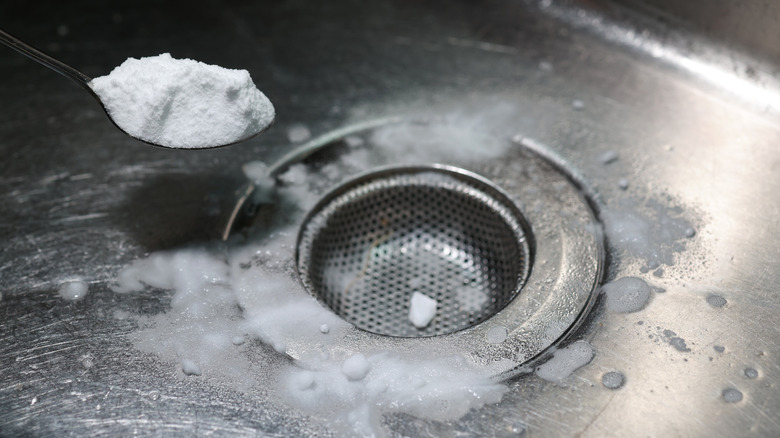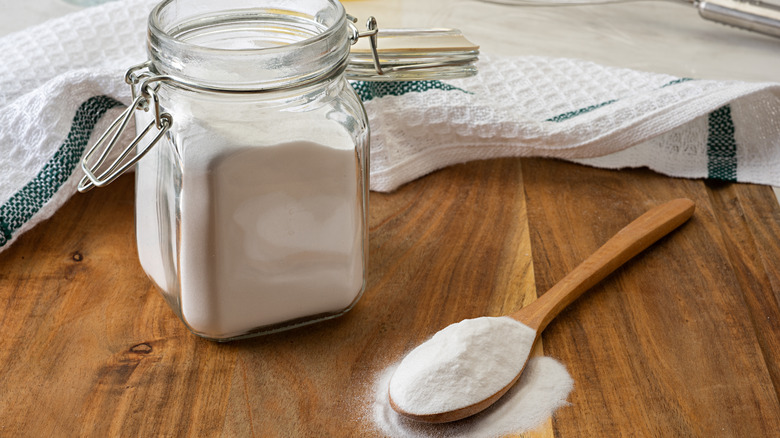Soda Crystals Are The Lesser-Known Way To Clean And Unclog Drains. Here's How
We may receive a commission on purchases made from links.
Do a cursory search for drain cleaning and unclogging remedies, and you're sure to see one combination over and over again: baking soda and vinegar. These two ingredients are beloved as natural cleaning products, but what you need to know about cleaning with a mixture of baking soda and vinegar is that they actually make each other useless. Some folks say that the fizzing reaction they cause is perfect for clearing drains, but really, this is nothing more than a small release of carbon dioxide gas, which gets washed down the drain about as quickly as water. Instead, you should try using soda crystals to clean and unclog your drains.
What are soda crystals, also known as soda ash and washing soda, and how do you use it? Soda crystals are made of sodium carbonate, also known as soda ash and washing ash. Don't confuse sodium carbonate with baking soda's official name, sodium bicarbonate. Even though they look the same and have similar names, soda crystals are a stronger alkaline substance and, thus, better suited to heavy-duty cleaning, like clogged and dirty drains. Many drain blockages are caused by grease and food particle buildup, and hard water minerals can accumulate over time. Luckily, soda crystals are well suited to eliminating both of these issues.
How to use soda crystals to clean drains
To use soda crystals to clear any blockages, you'll need some boiling water as well. It's best to use a kettle for this so you can control the rate at which the water flows out, but you can also add boiling water from a pot to a temperature-safe measuring cup with a spout. Slowly drizzle the hot water into the drain — if you're dealing with a partial blockage, this may take a while, but it is an important step to clear some of the initial gunk.
After it's fully drained, pour a heaping cup of soda crystals down the drain. To work its magic, allow the sodium carbonate to sit for 5 to 10 minutes. This gives the alkaline substance time to neutralize and break down acidic chemicals, like grease, while mingling with water to eliminate any hard water buildup. After letting it sit, boil another kettle of water and pour it over the drain. You may see some resistance, splashes, and gurgling at this point, but this is a sign that everything is working. When the kettle is empty, check to see how your drain is emptying. If you have a significant or several blockages, you may need to repeat this process a few times.
The best treatment against drain blockages is prevention, so be sure to clean your drains regularly. You can use soda crystals every week or so using the same method described above.
Considerations when cleaning with soda crystals
Sodium carbonate is free of harsh chemicals, generally safe to use if handled appropriately, and very affordable. But like any cleaning product, it can be dangerous if ingested, inhaled, comes in contact with the eyes, or exposed to skin for a prolonged period. You may want to use some personal protective equipment, such as cleaning gloves and goggles, to prevent any possible contact. Between uses, you can store it in any cool, dry, dark cupboard.
Although soda crystals are fantastic cleaners and have lots of uses around the house, you do not want to use them on anything aluminum, such as cooking pots and pans. This alkaline substance is corrosive on aluminum and can damage and discolor it. Be aware that you can mix soda crystals with some other household cleaners, such as liquid laundry detergent, but you should always research the combination before using it in your home. Lastly, do not confuse soda crystals (soda ash) with caustic soda, also known as lye, which is used for commercial and industrial-grade drain and oven cleaners and is incredibly strong. Soda crystals should be available in most grocery store cleaning aisles, but you can also order an 80-ounce bag of Sky High Suds' All-Natural Washing Soda for $16.49 on Amazon.

